Amongst the conversations that were kicked along yesterday with the coincident trip of both units at Callide C in central QLD were two that particularly caught my attention:
Conversation #1 was sparked, in part, by this question by an anonymous reader at WattClarity, asking about the processes AEMO uses to determine when to issue Market Notices after market events.
Conversation #2 was sparked by Mike Davidson’s addition to Stuart Banks’ note on LinkedIn about the price movement seen around the middle of the day yesterday across all regions.
In a way, both conversations are tied together as we will see…
(A) Surprise jump in Operational Demand in South Australia (Wed 13th Jan 2021)
Mike Davidson showed one depiction of a surprise jump in Operational Demand, so I took a look at the same with the ‘Forecast Convergence’ widget inside of ez2view and would include a couple snapshots here to illustrate.
Firstly there is a graphical depiction (using the AEMO’s ‘Demand and Non-Scheduled Generation’ figures) to show what amounts to a ~500MW jump in demand compared to expectations, happening rapidly and out of the blue:
To put this in relative terms (which is important to understand, in terms of market impacts) the actual Demand-and-NSG number for the 10:30 trading period was 1,506MW … whereas the expectation less than an hour beforehand was that it would be 1,042MW. That’s 45% higher!
With ‘Forecast Convergence’ in ez2view we can flip to a tabular view, which is what we see below:
Now, frequent readers will remember that this measure might be loosely termed as ‘Grid Demand’, which is different to (i.e. lower than) what a layperson might think of as ‘Underlying Demand’ (because an increasing amount of this Underlying Demand is being met by supply from embedded generation – primarily rooftop PV).
(A1) Market Impacts of this surprise jump in Grid Demand
Flipping the tabular view in ‘Forecast Convergence’ in ez2view to look at Trading Price rather than Demand, we see that the price spiked significantly higher than expectations as a result of the unexpected and rapid ramp in demand on the grid:
Included in the Trading Prices for the 10:00 and 10:30 trading periods were spikes in the 10:00 and 10:05 dispatch intervals to $1,015.13/MWh … which indicates, further, that the spike in demand was really out of the blue. Here’s a snapshot automatically captured from a display copy of NEMwatch v10 that we have running in our office:
(the demand metric shown in NEMwatch is ‘Total Demand’ … which is closer to ‘Scheduled Demand’)
(A2) Probable cause(s?) of this sudden ramp in Grid Demand
As alluded to above, ‘Grid Demand’ is essentially what’s left (i.e. to be supplied from the grid) after Embedded Generation (mainly rooftop PV) meets its own share of ‘Underlying Demand’.
—-
The AEMO has previously published papers outlining some concerns about what might happen when Grid Demand approaches zero due to the ongoing rise of rooftop PV, such as:
(a) A chapter devoted to the challenges in the ESOO 2020; and
(b) Notices like about possible inertia shortfall; and
(c) Specially focused documents, like the ‘Operational management of low demand in South Australia’.
—-
So we can understand that a sudden and unforecast steep drop in rooftop PV production would have led to an equivalent ramp in Grid Demand.
Remembering that the contribution of rooftop PV is not actually metered but rather estimated (by different methods) or inferred (from its impact on Grid Demand) I’ve included two different estimates (from the AEMO and the APVI) in the following trend from NEMreview v7:
Licensed users can access their own copy of this query here.
In ‘Forecast Convergence’ in ez2view we are also able to look at Unit Targets, as received by AEMO, and compare them to prior expectations. There are not (yet!) many Large Solar Farms in South Australia, but here is the view of how they collectively also surprised on the downside. This will also have been reflected in the price spikes above.
This view tends to support the conclusion that it was rooftop PV that curtailed sharply, driving Grid Demand higher.
—-
However it’s also worth noting that (if there was a large enough cloud bank crossing over Adelaide, deep and dark enough to snuff out most of the production of rooftop PV in a short space of time) that there might have been a small amount of the increase in consumption associated with increasing lighting load?
(B) A distinction between Credible Contingencies and Non-Credible Contingencies
I appreciated the discussion that ensued offline, following the coincident trip of both units at Callide C yesterday.
As noted in response to the question on WattClarity yesterday, the AEMO issued the Market Notice following the because it was a “non-credible contingency”, not because of the level of the frequency nadir.
(B1) Reminder about N-1 and N-2
Power stations are typically designed to not have common points of failure across units, hence:
1) One unit tripping (N-1) is seen as “credible” … in that it’s expected that this will happen from time to time, even if we don’t necessarily like it when it happens. As Hugh Saddler noted, (unit) ‘trips are normal’.
2) However two units tripping at the same time (N-2) is seen as “non-credible” … or, in other words, not normally expected. This event will trigger an investigation to ensure its cause is understood and not repeated.
(B2) AEMO Operating procedure
One of the more learned NEM junkies yesterday reminded me about the AEMO’s “Power System Security Guidelines’ (SO_OP_3715):
… and particularly section 7.2 which notes:
“Non-credible contingency events are contingency events other than credible contingency events. Events which are considered to be non-credible contingency events include:
• The trip of any busbar in the transmission network
• The trip of more than one transmission element
• The trip of more than one network element in circumstances as described in AEMO interpretation of contingency event item (1) above
• The trip of transmission plant in a manner that is not normal (e.g. protection operated but did not isolate the plant as per design)
• The trip of multiple generating units
• The trip of more than one load block where the combined load lost exceeds that which would normally be considered a credible contingency event in that region
• A combination of transmission plant, scheduled generating units or load, where that combination is not normally considered likely”
(B3) Market impacts of something being considered ‘credible’
They are not just weasel words … ‘credible’ and ‘non-credible’. There are real market (i.e. cost to energy user) impacts when certain market events are formally considered credible events.
These will be seen, for instance, in the outcome of what happened with Callide C yesterday – such as in Market Notice 82140 today in which AEMO says:
_________________________________________________
Notice ID : 82140
Notice Type ID : Reclassify contingency events
Notice Type Description : MARKET
Issue Date : Thursday, 14 January 2021
External Reference : Update – Non-credible contingency event – Qld region – 13/01/2021
__________________________________________________
AEMO ELECTRICITY MARKET NOTICE.
Update – Non-credible contingency event – Qld region – 13/01/2021
Refer AEMO Electricity Market Notice 82117
At 1057 hrs 13/01/2021 the Callide C3 and the Callide C4 units tripped.
AEMO did not instruct load shedding.
AEMO has not been advised of any disconnection of bulk electrical load.
The cause of this non credible contingency event is not known at this stage.
AEMO is not satisfied that this non credible event is unlikely to re-occur.
AEMO has therefore reclassified this event as a credible contingency event from 1125 hrs 14/01/2021 until further notice.
Constraint Set Q-CALLIDE_CPP_N-2 invoked until further notice.
Constraint set contains the following interconnectors on the left hand side.
N-Q-MNSP1
NSW1-QLD1
Manager NEM Real Time Operations
A quick reference to Constraint Set ‘Q-CALLIDE_CPP_N-2’ in ez2view today shows 9 different constraint equations invoked in the set, each of which will have an impact on market outcomes:
(C) Fun times ahead in the NEM …
When we were collaborating with the GVSC team 2 years ago to prepare the Generator Report Card 2018, we made sure that we included a specific focus on how the NEM is becoming increasingly dependent on the weather:
This was discussed in Theme 6 within Part 2 of the 180-page analytical component inside of the GRC2018. Should we find time to repeat the mammoth process again this year to produce an update in the form of the Generator Report Card 2020, we will seek to extend these thoughts further.
It’s interesting to note that the difference in approach taken by the AEMO between the two events yesterday, and the questions this throws up about the way management of the grid (and the market) will need to change over time as this energy transition rolls on:
Event #1) We have a coincident trip of both units at Callide C which delivered, via an ~800MW loss of supply, a drop in frequency (though no large spike in price at the time) that’s now seen as a credible contingency so will, at times, add to the cost of dispatching the market because the constraint equations cater for it.
Event #2) We have a significant (~500MW) net loss of supply from rooftop PV, plus some from large solar as well, that did deliver a price spike … and which might be expected to increase in scale in the years ahead as the rooftop PV juggernaut continues its progress. However that possibility is not being (explicitly?) catered for in the operating processes as its own type of “credible contingency”?
(D) … and not just in the NEM!
Coincidentally this morning I noticed that the California ISO had published its ’FINAL – Root Cause Analysis (Mid-August 2020 Extreme Heat Wave)’:
Quickly scanning the 143 page report, there were a number of things that jumped out, but particularly these two from a “Summary of Performance of Different Types of Resources” (numbered p5):
Observation #1) Echoing the considerations in my other article from yesterday, I read the following:
“Natural gas – Under very high temperatures, ambient derates are not uncommon for the natural gas fleet, and high temperatures reduce the efficiency of these resources. The CEC hosted a workshop to explore potential technology options for increasing the efficiency and flexibility of the existing natural gas power plant fleet to help meet near-term electric system reliability and the longer-term transition to renewable and zero-carbon resources.1 Subsequently, the CPUC issued a ruling intended to get the most out the existing gas fleet in its recently opened procurement rulemaking focused on summer 2021 resources.2 All reasonable efforts should be made to increase the efficiency of the existing fleet.”
Observation #2) Broadly related to (though not identical to) the problem that AEMO experienced yesterday with the disappearance of solar PV contributions (small rooftop PV and large solar farms):
“Solar and wind – The CPUC has improved the methods for estimating the reliability megawatt (MW) value of solar and wind over the years, but the reliability value of intermittent resources is still over-estimated during the net peak hour. Improvements to the RA program should account for time-dependent capabilities of intermittent resources.”
To my reading, this comment from CALISO speaks to both:
2a) The (relatively low) performance of this type of technology at times of ‘net peak’ demand; but also
2b) The degree to to which the performance is predictable ahead of time … which is the same type of challenge the AEMO was grappling with on Wednesday this week (albeit not at ‘net peak’ demand times).
———–
Fun times ahead, everywhere around the world that’s transitioning with increasing contributions of intermittent generation in a world where temperatures are rising…
———–
PS1 on Friday 15th Jan 2021
Worth noting that there are also conversations this has spawned here on LinkedIn (and this spin-off started by James Luffman) that you might like to keep an eye on, and also a couple questions and comments popping up on Twitter here and possibly here as well.


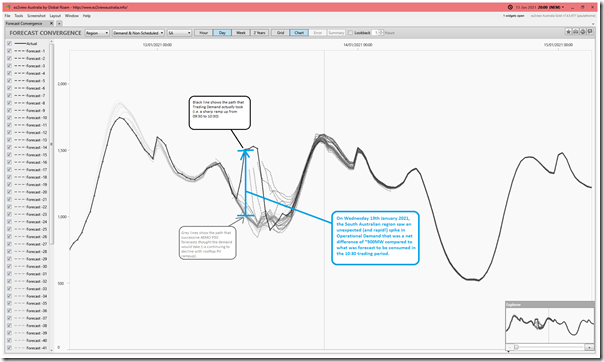
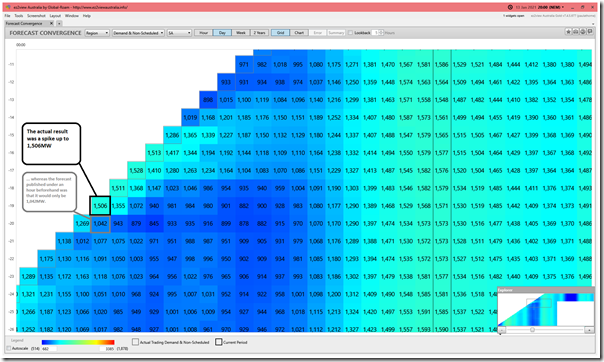
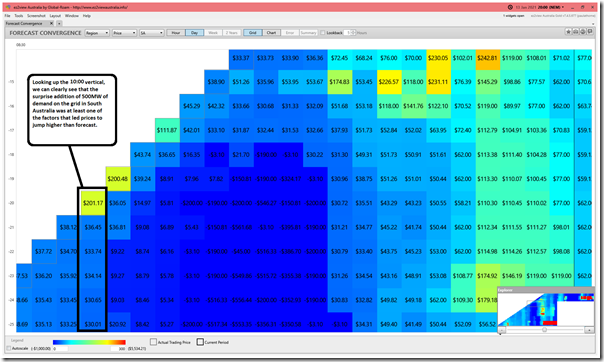
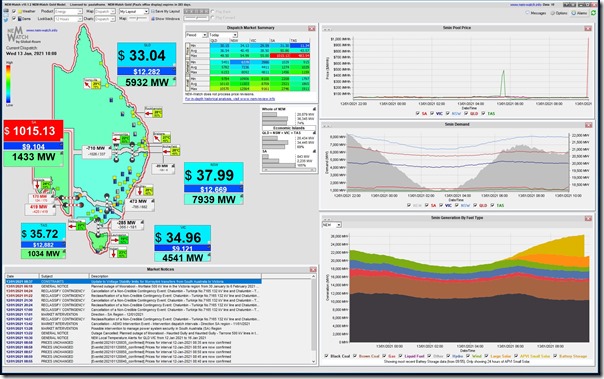
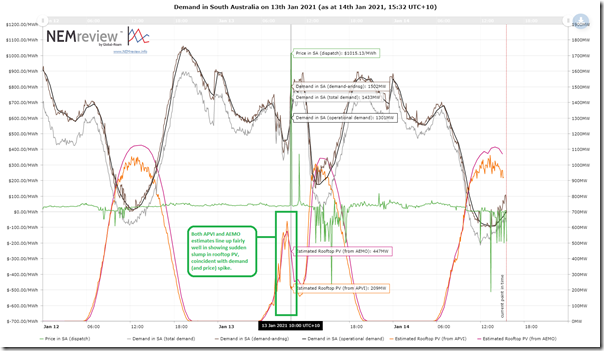
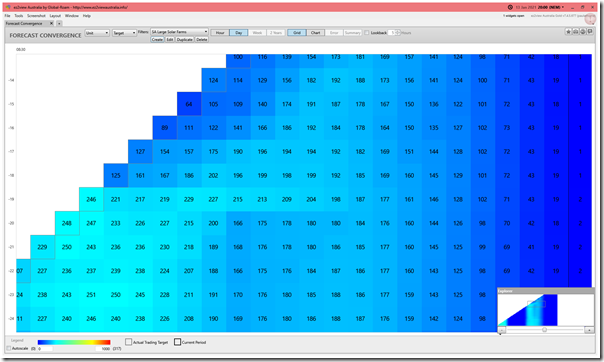
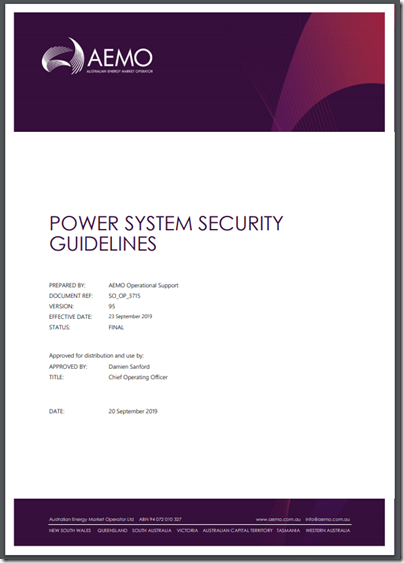
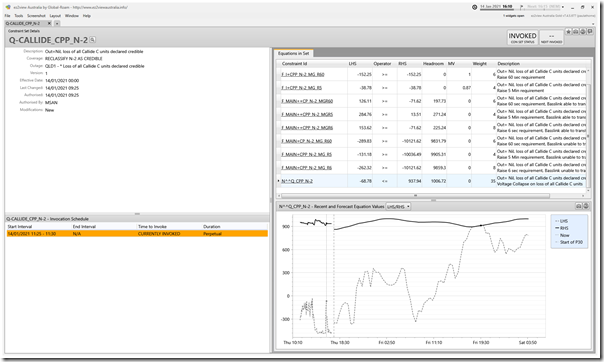

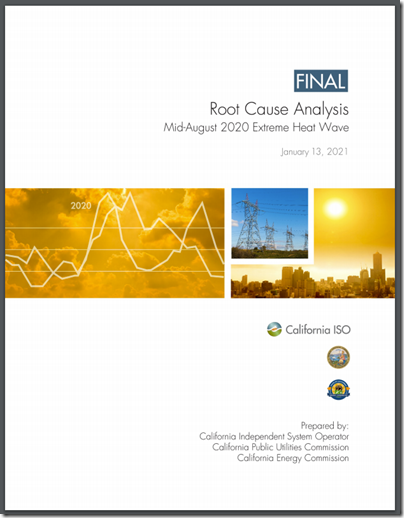
These type of demand reductions are unusual enough that you are writing about them. This makes me wonder what was so different this time? One of the many problems is that the information that should be available from every point of presence via communicating meters is not actually available because there aren’t enough communicating meters, not enough software to exploit their information, and maybe not enough sensors. So if it was cloud cover or rain or a substations or two dropping the centralised data system really should have awareness. Cloud cover for instance generally has a pattern and and can be predicted. Its interesting but (i) what was different this time and (ii) we need to exploit the information each point of presence provides.
There was indeed a cloudbank with associated rainfall that passed over parts of SA on Wednesday morning. It was mentioned on local radio as being over the Eyre Penisula about 9 am and arrived over Adelaide in late morning. It was clearly visible on the BoM radar proceeding in an ENE direction. By mid afternoon the sky over Adelaide was complete clear.
If anyone can confirm or otherwise that it was a big cloud that caused the loss of 500 MW of rooftop solar in South Australia last week please post your thoughts. This is a big deal as it represented a sudden 45% increase in forecast demand for the entire state of South Australia.
Yes, my Enphase recording system shows a big drop to 10:30am to 12:45 pm Adelaide time. AT 1pm it shot back up from 800W to 4kW